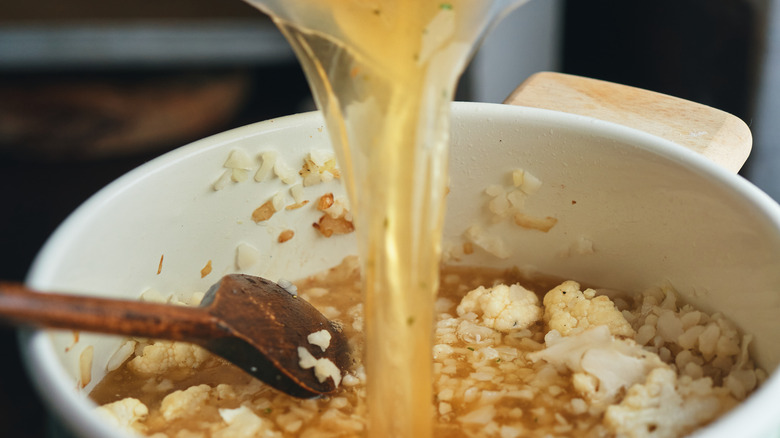The Blending Tip To Ensure Your Soups Don't Turn Out Watery
From chunky corn chowder to silky cream of broccoli, puréed soups have a rich and comforting thickness that hits the spot on a cold day. While you might think that their creamy, thick consistency is the simple result of blending the cooking liquid and cooked ingredients together in one go, you're missing an important step: Reserving some of the cooking liquid.
Whether you use exact measurements or simply top sautéed veggies, aromatics, or legumes with liquid before boiling them, you might end up with more cooking liquid than you bargained for. When there's a disproportionately high ratio of liquid to solids, blending everything all at once will result in watery soup. Therefore, the best way to achieve that ideal thick, creamy consistency is to save a ladle or two of the cooking liquid to the side before adding cooked soup veggies and broth to the blender or inserting a hand emulsifier into the pot.
Once you've blended the ingredients to the desired smoothness, you can then determine whether your soup needs that reserved cooking liquid or not. If you want to add the liquid back in, you can add it in small increments, so you have total control over the thinning process. If you're finishing off your puréed soup with dairy or nondairy milk or cream, the tip still applies; even though cream and milk are thickening agents, they still add more liquid to the pot. You can first stir the cream into the puréed soup, then finish with the reserved liquid should you want to thin it.
What to do if your soup is still too thin
This two-step blending tip is the best way to prevent watery soup because you're in control of how much of the reserved liquid you add back to the pot. If, for some reason, you still end up with a thin or watery consistency, there are a few ways to retroactively thicken your soup using common household staples.
Both flour and cornstarch are great soup thickening agents that won't affect its flavor. To thicken watery soup purée with flour or cornstarch, you'll need to ladle about a cup of soup into a separate bowl before adding 2 or 3 tablespoons of starch or flour. Then, whisk the mixture until the starch or flour fully dissolves before stirring it back into the purée.
Another option is to thicken your soup with egg yolks, by slowly adding a ladle of soup to the egg yolks, then whisking to combine everything before adding the tempered egg mixture into your pot of soup. It's important to add the yolks to the puréed soup once it stops bubbling to avoid curdling. Lastly, if your puréed soup is only slightly thin, simmering it for another five or ten minutes may be all it needs to evaporate that small bit of extra liquid.

